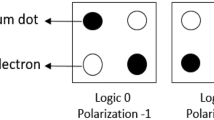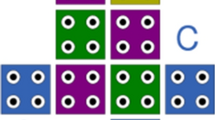Abstract
Some of the vital problems around the conventional CMOS technology are leakage-power consumption, physical-scalability limits, and short-channel effects. These deficiencies have led to many studies about nano-scale designs. Quantum dot cellular automata (QCA) is a potential answer in nanotechnology. Scholars have considered the four-dot squared cell as the main factor in the QCA. Also, a full-adder is a fundamental unit in every digital system. However, the importance of cell and area consumption limitation in circuit designing has been completely ignored in most of the related studies. Therefore, in this paper, we have offered a one-bit multi-layer full-adder cell. The practical accuracy of the proposed circuits has been assessed using QCADesigner. According to the obtained results and the design, the presented design has efficient cell usage against all the prior designs regarding cell counts and area occupation, leading to around 7% improvement in cell number than the common full-adder design. The simulation outcomes have also shown that the introduced design has excellent efficiency regarding cell and area aspects.












Similar content being viewed by others
References
Bolhassani, A., Haghparast, M.: Optimized designs of reversible arithmetic logic unit. Turk. J. Electr. Eng. Comput. Sci. 25(2), 1137–1146 (2017)
Seyedi, S., Darbandi, M., and Navimipour, N. J.: Designing an efficient fault tolerance D-latch based on quantum-dot cellular automata nanotechnology. Optik 185, 827–837 (2019)
Roy, K., Mukhopadhyay, S., Mahmoodi-Meimand, H.: Leakage current mechanisms and leakage reduction techniques in deep-submicrometer CMOS circuits. Proc. IEEE 91(2), 305–327 (2003)
Schmidt, V., Riel, H., Senz, S., Karg, S., Riess, W., Gösele, U.: Realization of a silicon nanowire vertical surround-gate field-effect transistor. Small 2(1), 85–88 (2006)
Abu El-Seoud, A., El-Banna, M., Hakim, M.: On modelling and characterization of single electron transistor. Int. J. Electron. 94(6), 573–585 (2007)
Navi, K., Sayedsalehi, S., Farazkish, R., Azghadi, M.R.: Five-input majority gate, a new device for quantum-dot cellular automata. J. Comput. Theor. Nanosci. 7(8), 1546–1553 (2010)
Seyedi, S., Darbandi, M., Navimipour, N.J.: Designing an efficient fault tolerance D-latch based on quantum-dot cellular automata nanotechnology. Optik 185, 827–837 (2019)
Seyedi, S., Ghanbari, A., Navimipour, N.J.: New design of a 4-bit ripple carry adder on a nano-scale quantum-dot cellular automata. Mosc. Univ. Phys. Bull. 74(5), 494–501 (2019)
Mosleh, M.: A novel design of multiplexer based on nano-scale quantum-dot cellular automata. Concurrency Computat. Pract. Exper. 31(13), e5070 (2019)
Mohammadi, Z., Mohammadi, M.: Implementing a one-bit reversible full adder using quantum-dot cellular automata. Quantum Inf. Process. 13(9), 2127–2147 (2014)
Andrecut, M., Ali, M.: Entanglement dynamics in quantum cellular automata. Phys. Lett. A 326(5), 328–332 (2004)
Hasani, B., Navimipour, N. J.: A new design of a carry-save adder based on quantum-dot cellular automata. Iran. J. Sci. Technol. Trans. Electr. Eng. 45, 993–999 (2021)
Banik, D., Rahaman, H.: Quantum-dot cellular automata latches for reversible logic using wave clocking scheme. IETE J. Res. (2020). https://doi.org/10.1080/03772063.2020.1819886
Kim, K., Wu, K., Karri, R.: The robust QCA adder designs using composable QCA building blocks. IEEE Trans. Comput. Aided Des. Integr. Circuits Syst. 1(26), 176–183 (2007)
Gadim, M.R., Navimipour, N.J.: A new three-level fault tolerance arithmetic and logic unit based on quantum dot cellular automata. Microsyst. Technol. 24, 1295–1305 (2018)
Sarvaghad-Moghaddam, M., Orouji, A.A.: New symmetric and planar designs of reversible full-adders/subtractors in quantum-dot cellular automata. Eur. Phys. J. D 73(6), 125 (2019)
Fam, S.R., Navimipour, N.J.: Design of a loop-based random access memory based on the nanoscale quantum dot cellular automata. Photon Netw. Commun. 37(1), 120–130 (2019)
Walus, K., Jullien, G.A.: Design tools for an emerging SoC technology: quantum-dot cellular automata. Proc. IEEE 94(6), 1225–1244 (2006)
Lent, C.S., Tougaw, P.D., Porod, W., Bernstein, G.H.: Quantum cellular automata. Nanotechnology 4(1), 49 (1993)
Sandhu, A., Gupta, S.: Performance evaluation of an efficient five-input majority gate design in QCA nanotechnology. Iran. J. Sci. Techno. Trans. Electr. Eng. (2019). https://doi.org/10.1007/s40998-019-00296-2
Das, J.C., De, D.: Reversible priority encoder design and implementation using quantum-dot cellular automata. IET Quantum Commun. 1(2), 72–78 (2020)
Ilanchezhian, P., Parvathi, R.: Nanotechnology based effective design approach for code converter circuits using QCA. Int. J. Comput. Appl. 69(8) (2013)
Latha, K., Maharshi, M.N.: Design of adders using qca. Int. J. Adv. Eng. Technol. 6(4), 1750 (2013)
Das, J.C., De, D.: Operational efficiency of novel SISO shift register under thermal randomness in quantum-dot cellular automata design. Microsyst. Technol. 23, 4155–4168 (2017)
Nejad, M.Y., Mosleh, M.: A review on QCA multiplexer designs. Majlesi J. Electr. Eng. 11(2), 69–79 (2017)
Rao, N.G., Srikanth, P., Sharan, P.: A novel quantum dot cellular automata for 4-bit code converters. Optik-Int. J. Light Electron Optics 127(10), 4246–4249 (2016)
Sen, B., Mukherjee, R., Mohit, K., Sikdar, B.K.: Design of reliable universal QCA logic in the presence of cell deposition defect. Int. J. Electron. 104(8), 1285–1297 (2017)
Seyedi, S., Navimipour, N.J.: Design and evaluation of a new structure for fault-tolerance full-adder based on quantum-dot cellular automata. Nano Commun. Netw. 16, 1–9 (2018)
Ahmad, F., Bhat, G.: Novel code converters based on quantum-dot cellular automata (QCA). Int. J. Sci. Res. 3(5), 364–371 (2012)
Pudi, V., Sridharan, K.: Efficient design of a hybrid adder in quantum-dot cellular automata. IEEE Trans. Very Large Scale Integr (VLSI) Syst. 19(9), 1535–1548 (2010)
Heikalabad, S.R., Kamrani, H.: Design and implementation of circuit-switched network based on nanoscale quantum-dot cellular automata. Photonic Netw. Commun. 38(3), 356–377 (2019)
Molahosseini, A.S., Navi, K., Dadkhah, C., Kavehei, O., Timarchi, S.: Efficient reverse converter designs for the new 4-moduli sets and based on new CRTs. IEEE Trans. Circuits Syst. I Regul. Pap. 57(4), 823–835 (2010)
Peskin, U., Abu-Hilu, M., Speiser, S.: Approaches to molecular devices based on controlled intramolecular electronic energy and electron transfer. Electron transfer rates through flexible molecular bridges by a time-dependent super exchange model. Opt. Mater. 24(1), 23–29 (2003)
Moharrami, E., Navimipour, N.J.: Designing nanoscale counter using reversible gate based on quantum-dot cellular automata. Int. J. Theor. Phys. 57, 1060–1081 (2018)
Seyedi, S., Navimipour, N.J.: Designing a new 4:2 compressor using an efficient multi-layer full-adder based on nanoscale quantum-dot cellular automata. Int. J. Theor. Phys. 60, 2613–2626 (2021)
Navi, K., et al.: A novel low-power full-adder cell with new technique in designing logical gates based on static CMOS inverter. Microelectron. J. 40(10), 1441–1448 (2009)
Zhang, Y., Lv, H., Du, H., Huang, C., Liu, S., Xie, G.: Modular design of QCA carry flow adders and multiplier with reduced wire crossing and number of logic gates. Int. J. Circ. Theor. Appl. 44(7), 1351–1366 (2015)
Ghosh, B., Singh, C., Salimath, A.K.: A novel approach of full adder and arithmetic logic unit design in quantum dot cellular automata. J. Low Pow. Electron. 9(4), 452–457 (2013)
Kianpour, M., Sabbaghi-Nadooshan, R.: A conventional design and simulation for CLB implementation of an FPGA quantum-dot cellular automata. Microprocess. Microsyst. 38(8), 1046–1062 (2014)
Lent, C.S., Tougaw, P.D.: A device architecture for computing with quantum dots. Proc. IEEE 85(4), 541–557 (1997)
Wang, W., Walus, K., and Jullien, G. A.: “Quantum-dot cellular automata adders,” in Nanotechnology, 2003. IEEE-NANO 2003. 2003 Third IEEE Conference on, 2003, 1, 461–464: IEEE
Angizi, S., Alkaldy, E., Bagherzadeh, N., Navi, K.: Novel robust single layer wire crossing approach for exclusive or sum of products logic design with quantum-dot cellular automata. J. Low Pow. Electron. 10(2), 259–271 (2014)
Seyedi, S., Navimipour, N.J.: An optimized design of full adder based on nanoscale quantum-dot cellular automata. Optik-Int. J. Light Electron Optics 158, 243–256 (2017)
Zhang, R., Walus, K., Wang, W., Jullien, G.A.: A method of majority logic reduction for quantum cellular automata. IEEE Trans. Nanotechnol. 3(4), 443–450 (2004)
Labrado, C., Thapliyal, H.: Design of adder and subtractor circuits in majority logic-based field-coupled QCA nanocomputing. Electron. Lett. 52(6), 464–466 (2016)
Roohi, A., Khademolhosseini, H., Sayedsalehi, S., Navi, K.: A symmetric quantum-dot cellular automata design for 5-input majority gate. J. Comput. Electron. 13(3), 701–708 (2014)
Akeela, R., Wagh, M.D.: A five-input majority gate in quantum-dot cellular automata. NSTI Nanotech 2, 978–981 (2011)
Angizi, S., Sarmadi, S., Sayedsalehi, S., Navi, K.: Design and evaluation of new majority gate-based RAM cell in quantum-dot cellular automata. Microelectron. J. 46(1), 43–51 (2015)
Hashemi, S., Tehrani, M., Navi, K.: An efficient quantum-dot cellular automata full-adder. Sci. Res. Essays 7(2), 177–189 (2012)
Kumari, A., Bhanja, S.: Landauer clocking for magnetic cellular automata MCA arrays. IEEE Trans. Very Large Scale Integr. (VLSI) Syst. 19(4), 714–717 (2011)
Lent, C.S., Liu, M., Lu, Y.: Bennett clocking of quantum-dot cellular automata and the limits to binary logic scaling. Nanotechnology 17(16), 4240 (2006)
Sayedsalehi, S., Moaiyeri, M.H., Navi, K.: Novel efficient adder circuits for quantum-dot cellular automata. J. Comput. Theor. Nanosci. 8(9), 1769–1775 (2011)
Navi, K., Roohi, A., Sayedsalehi, S.: Designing reconfigurable quantum-dot cellular automata logic circuits. J. Comput. Theor. Nanosci. 10(5), 1137–1146 (2013)
Abedi, D., Jaberipur, G., Sangsefidi, M.: Coplanar full adder in quantum-dot cellular automata via clock-zone-based crossover. IEEE Trans. Nanotechnol. 14(3), 497–504 (2015)
Sarmadi, S., Sayedsalehi, S., Fartash, M., Angizi, S.: A structured ultra-dense QCA one-bit full-adder cell. Quant. Matt. 5(1), 118–123 (2016)
Seyedi, S., Navimipour, N.J.: An optimized design of full adder based on nanoscale quantum-dot cellular automata. Optik 158, 243–256 (2018)
Walus, K., Dysart, T.J., Jullien, G.A., Budiman, R.A.: QCADesigner: a rapid design and simulation tool for quantum-dot cellular automata. IEEE Trans. Nanotechnol. 3(1), 26–31 (2004)
Mohammadi, M., Mohammadi, M., Gorgin, S.: An efficient design of full adder in quantum-dot cellular automata (QCA) technology. Microelectron. J. 50, 35–43 (2016)
Heikalabad, S.R., Asfestani, M.N., Hosseinzadeh, M.: A full adder structure without cross-wiring in quantum-dot cellular automata with energy dissipation analysis. J. Supercomput. 74(5), 1994–2005 (2018)
Sasamal, T.N., Singh, A.K., Mohan, A.: An optimal design of full adder based on 5-input majority gate in coplanar quantum-dot cellular automata. Optik 127(20), 8576–8591 (2016)
Navi, K., Farazkish, R., Sayedsalehi, S., Azghadi, M.R.: A new quantum-dot cellular automata full-adder. Microelectron. J. 41(12), 820–826 (2010)
Cho, H., Swartzlander, E.E., Jr.: Adder and multiplier design in quantum-dot cellular automata. IEEE Trans. Comput. 58(6), 721–727 (2009)
Mohammadyan, S., Angizi, S., Navi, K.: New fully single layer QCA full-adder cell based on feedback model. Int. J. High Perform. Syst. Archit. 5(4), 202–208 (2015)
Author information
Authors and Affiliations
Corresponding author
Additional information
Publisher's Note
Springer Nature remains neutral with regard to jurisdictional claims in published maps and institutional affiliations.
Rights and permissions
About this article
Cite this article
Seyedi, S., Navimipour, N.J. Designing a three-level full-adder based on nano-scale quantum dot cellular automata. Photon Netw Commun 42, 184–193 (2021). https://doi.org/10.1007/s11107-021-00949-5
Received:
Accepted:
Published:
Issue Date:
DOI: https://doi.org/10.1007/s11107-021-00949-5




